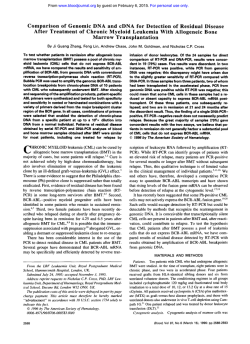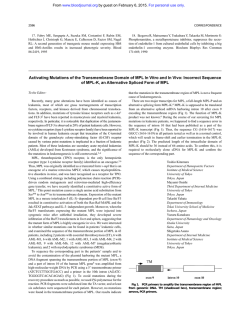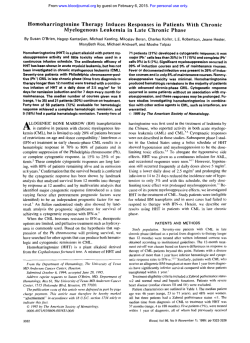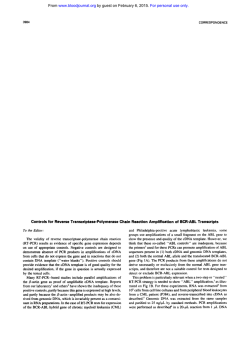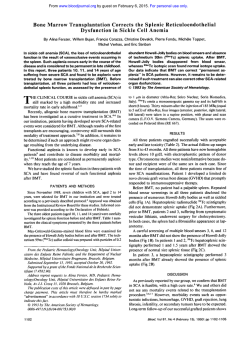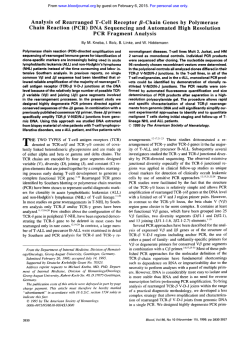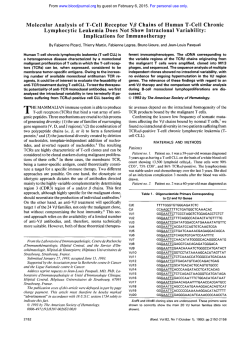
A New Method of “In-Cell Reverse Transcriptase
From www.bloodjournal.org by guest on February 6, 2015. For personal use only. A New Method of “In-Cell Reverse Transcriptase-Polymerase Chain Reaction” for the Detection of BCRIABL Transcript in Chronic Myeloid Leukemia Patients By Nicoletta Testoni, Giovanni Martinelli, Patrizia Farabegoli, Alfonso Zaccaria, Marilina Amabile, Donatella Raspadori, Susanna Pelliconi, Eliana Zuffa, Cristina Carboni, and Sante Tura Methods of detecting minimal residual disease (MRD) in chronic myeloid leukemia (CML) include chromosome analysis, Southern blotting, polymerase chain reaction (PCR) and fluorescent in situ hybridization (FISH) techniques. We report a novel method t o detect intracellular messenger RNA (mRNA) by combining the techniques of reverse transcription (RT) and PCR performed directly inside the cells, without extraction of the nucleic acid. We applied this method, which we call ”in-cell RT-PCR”, t o detect hybrid BCRIABL transcript within single cells. After cellular permeabilization and fixation of single cells in suspension, the neoplastic mRNA was reverse transcribed into cDNA, and the cDNA was amplified by PCR with fluorescent primers, specific for bcrlabl. Flow cytometry was used t o detect cells positive for the amplified DNA within the cell cytoplasm. After transferring the amplified cells onto slides by cytospin, the positive cells for BCR/ ABL cDNA were observed by fluorescent microscopy. The technique was capable of detecting l o w abundancy signals and distinguishing different levels of gene expression. The amplification products were found in the cells and superna- tants. The distribution was critically affected by the protease digestion condition. The specificity of amplification was confirmed by a nested RT-PCR of BCRIABL performed on extracted mRNA from the same sample, and by reamplification of supernatants. We have used the technique t o study 10 Ph’ CML patients and three normal subjects as controls. Four patients were 100% Ph+at diagnosis time and RT-PCR’ at cytogenetic and molecular analysis, respectively. In-cell RT-PCR showed that the residual non-neoplastic cells could be observed in all cases. In t w o patients undergoing interferon-a (IFN-a) therapy and in four bone-marrow transplanted patients, the in-cell RT-PCR was used t o compare the level of Ph’ positivity detected by cytogenetic analysis with the number of cells expressing BCRIABL transcript. In this manner, we could estimate the MRD. Our preliminary application of the technique suggests that it is capable of accurately identifying cells transcribing bcrlabl, and that it may have significant clinical applications in the detection of MRD. 0 1996 by The American Society of Hematology. I with a sensitivity of 1/10,000. Even though the latter technique is very sensitive, by itself, it is not capable of providing information on the real size of the residual clone, although some new modifications may overcome this short-coming.’” Fluorescent in situ hybridization (FISH) could solve this problem, but the procedure is difficult, expensive, and requires sophisticated equipment.” The results described here are based on two methods: one for the detection of human immunodeficiency virus (H1V)-1 DNA and mRNA both in cell lines and in the blood of HIV-1 infected patients by insitu amplification of RNA followed by hybridization with fluorescent probe^,'^,'^ and another for the amplification and linkage of the rearranged immunoglobulin heavy and light chain v-genes within single cells using PCR with specific fluorescent primers.I4 We have devised and tested a new method described herein, in which the hybrid mRNA is reverse transcribed (RT) within the cells, and the resulting cDNA is amplified using the PCR technique with fluorescent primers. We describe this easy, sensitive, and inexpensive technique, which we call the “in-cell RT-PCR” assay. N CHRONIC MYELOID leukemia (CML) the reciprocal translocation between chromosomes 9 and 22, which leads to the formation of the Philadelphia chromosome (Ph),’ allows the Abelson proto-oncogene (ABL) to move to breakpoint cluster region (M-BCR) of chromosome 22.2-4 Consequently, a hybrid BCWABL transcription unit is created. The resultant 8.5-kb mRNA is translated into a hybrid protein of 210 kD (p210) with increased tyrosine kinase a~tivity.~ The presence of a cytogenetic and a molecular marker in the leukemic clone allows a correct diagnosis of the disease and a careful follow-up of the residual leukemic clone after ablative treatment, such as allogenic or autologous bone marrow transplantation (BMT),~or after successful interferona (IFN-a)treatment.’ Detection of minimal residual disease (MRD) is possible either by cytogenetics or Southern blotting methods,’ which are able to detect up to 1% to 2% of residual disease, or by polymerase chain reaction (PCR)9 From the Institute of Haematology “L. e A. Seragnoli”, University of Bologna, Bologna, Italy. Submitted November 21, I995; accepted December 19, 1995. Supported by the “Associazione Italiana per la Ricerca sul Cancro (AIRC)”, by the CNR “ACRO” Grant No. 94.OI222.PF39 and by the CNR Contract No. 952206 target projects. Address reprint requests to Giovanni Martinelli, MD, Institute of Haematology “L. e A. Ser&gnoli”, University of Bologna, Policlinico S. Orsola, Via Massarenti 9, 40138, Bologna, Italy. The publication costs of this article were defrayed in part by page charge payment. This article must therefore be hereby marked “advertisement” in accordance with I8 U.S.C. section 1734 solely to indicate this fact. 0 I996 by The American Society of Hematology. 0006-497I/96/8709-OO02$3.00/0 3822 MATERIALS AND METHODS Patients. To assess the specificity and the sensitivity of the “incell RT-PCR” assay in cases with different percentages of Ph’ cells as determined by cytogenetic analysis and of mixed chimerism, we selected three normal subjects and 10 CML patients. After obtaining informed consent, 10 CML patients who were cytogenetic Ph’ and RT-PCR+ for BCRIABL transcript, were admitted to the study (see Table 1). Four patients were studied at the time of diagnosis and showed the t(9;22)(34;qll) in all the observed metaphases (patients I through 4 in Table 1). Two patients (patients 5 and 6) were analyzed after 6 months of IF”-a therapy’ with different degrees of Ph+ metaphases (96% and 60%. respectively). Two other patients (patients 7 and 8) were studied for cytogenetic relapse after BMT Blood, Vol 87, No 9 (May 1). 1996: pp 3822-3827 From www.bloodjournal.org by guest on February 6, 2015. For personal use only. IN-CELL RT-PCR 3823 Table 1. Cases, Phase of Disease, Karyotypic Molecular Analysis of CML Patients ~~ Patient No. Phase of Disease 1 2 3 4 5 6 7 8 9 10 11 12 13 Diagnosis Diagnosis Diagnosis Diagnosis IFN therapy IFN therapy Allo. BMT relapse Allo. BMT relapse Allo. BMT relapse Allo. BMT relapse Normal Normal Normal No. Metaphases Ph'Ph- (%Ph') 1510 (100) 2010 (100) 5810 (100) 2510 (100) 48/2 (96) 30120 (60) 31123 (57.4) 5/43 (10.4) 0160 (0) 0120 (0) Negative Negative Negative RT-PCR + + + + + + + + + -neg -neg -neg -neg Type of Transcript No. of Cells Detected by in Cell RT-PCR Cell+/Cell- b2-a2 b2-a2 b3-a2 b3-a2 b2-a2 b3-a2 b2-a2 b3-a2 b3-a2 b3-a2 neg neg neg 29314 19518 596124 7513 486114 116126 35117 471205 11106 01100 01133 01100 01148 Cell+ (%) 98.70 96.10 96.10 96.20 97.20 81.70 67.30 18.60 0.90 0 0 0 0 Comparison of cytogenetic, RT-PCR, and "in-cell" RT-PCR techniques on the samples from 10 different patients and three normal subjects. Patients 1 to 4 were CML patients at diagnosis, patients 5 and 6 were studied after IFN-a treatment, and patients 7 to 10 previously underwent BMT. The number of cases, phase of the disease, number of metaphases expressed as ratio between Ph' and Ph- and as percentage of Ph+ cells are reported. The result of each classical RT-PCR, the type of transcript detected at diagnosis in all cases, and the number of cells detected by in-cell RT-PCR expressed as ratio of positive (+) cellslnegative (-) cells and as percentage (%) of positive cells are also reported. performed from sibling bone marrow donors. At the time of RTPCR and in-cell RT-PCR, they were on IFN-(Ytherapy and had 31 of 54 and 5 of 45 Ph+ metaphases (57.4% and 10.4%). respectively. Patients 9 and 10 were also analyzed after allogeneic BMT during a complete clinical and cytogenetic remission: while patient 10 was also negative by nested primer PCR analysis and in molecular remission, patient 4 was still nested RT-PCR+ 6 months after BMT (molecular relapse). Cell preparation. Mononuclear cells from human bone marrow and peripheral blood samples were separated and isolated by centrifugation on Ficoll-Hypaque. Collected cells were washed twice in phosphate buffered saline (PBS) pH 7.2 and pelleted at 1,500 rpm for 10 minutes. We assessed the best conditions to perform the in-cell RT-PCR test, avoiding clamping or intracellular amplified release. The cells were resuspended and fixed in 4% paraformaldehyde solution (50 pL for 400,000cells) for 15 minutes at room temperature. Different concentrations of paraformaldehyde (2%, 4%, 10%);different fixing times (2, 5, 10, and 30 minutes) and temperature were analyzed for assessing the reproducibility of the test (data not shown). Overfixation and proteinase K over-digestion have been reported to give rise, respectively, to low amounts of amplified products and higher intracellular amplified product release resulting in a higher final background fluorescence. The method was then performed on the samples at the same fixing conditions mentioned above. Fixed cells were again washed twice in PBS and pelleted at 1,500 rpm for 10 minutes and resuspended in 50% ethanol and a final concentration of 1 to 2 x lo6/mL. They were stored in I-mL diquots at -20°C for up to 3 months. An aliquot was pelleted at 1,500 rpm for 5 minutes and washed in PBS, resuspended in 50 pL of proteinase K (1 pg/mL) (Boehringer Mannheim GmbH, Mannheim, Germany) in 0.1 moVL Tris HCI, 50 mmoVL EDTA buffer (pH 8), and incubated at 37°C for 10 minutes. Protease digestions of 5, 15, 30, 45, or 60 minutes were tested for optimal signal preservation. After digestion, cells were pelleted and washed as above, and underwent reverse transcription. In-cell reverse transcription. A total of 38 pL of a reaction mixture containing 100 U of reverse transcriptase, 90 mmoVL KCI, 100 mmollL Tris HCl (pH 8.3), 1.5 mmovL. MgCl, 200 mmoVL each of deoxyadenosine 5'-triphosphate (dATP), deoxycytidine 5'- triphosphate (dCTP), deoxyguanosine 5'-triphosphate (dGTP) and deoxythymidine 5' triphosphate (dlTP), 40 U of RNAsin RNase inhibitor and 50 pmol of the AZ FAM primer, were added to each sample. Samples were incubated at 37°C overnight (13 to 17 hours) and then placed in ice. In-cell DNA ampli$ca!ion. Cells were resuspended in 160 pL of a PCR reaction mixture containing 90 mmoVL KCl, 100 mmoY L Tris HCl (pH 8.3). 1.5 mmoVL MgCI, 200 mmoVL each of dATP, dCTP, dGTP, and dTTP, 100 pmol of the EA 122 FAM and 50 pmol of AZ FAM primers and 1 p L (5 U) of Taq polymerase. The PCR process is covered by United States patents owned by HoffmannLaRoche Inc Perkin Elmer Cetus. Samples were then cycled in an automated thermocycler (PCR Thermocycler Perkin Elmer 480, a commercially available machine; Branchburg, NJ), which was programmed for 25 cycles of thermal denaturation (94°C for 30 seconds), annealing (58°C for 30 seconds), and extension (72°C for 2 minutes). Slide preparation and amplijkation detection. After the in-cell RT-PCR step, cells were squashed onto glass slides. In each case, one slide was stained with Giemsa to evaluate cellular morphology after RT-PCR. Another slide was counterstained with propidium iodide (PI) in antifade, a coverslip sealed with nail varnish. The slides were examined and photographed by fluorescence microscopy with a dual pass filter specific for fluoroisothicyanate (FITC) and PI. With this filter, the amplified DNA exhibited a yellow green signal, and the nucleus was stained red. We used 640 ASA film (Scotch-3M) and double exposure to photograph the representative cells (magnification x 1,800). In some cases data acquisition from cytofluorimetric analysis was performed using Lysis I1 software (Becton Dickinson, San Jose, CA) by FACScan (Becton Dickinson). A total of 10,OOO cells were analyzed. To monitor cell integrity and to assess the level of cell damage, cell loss, and release of intracellular amplified product due to the squashing process, cell integrity and morphology were checked after the cytospin. A high proportion of cells (-20%) were found to be disrupted after the in-cell RT-PCR steps by centrifugation; we counted only those cells in which integrity and clear morphology were maintained. Furthermore, to monitor cell integrity and to assess the level of considerable cell damage due to the steps of fixation, digestion, reverse transcription, PCR, and cell transfer to From www.bloodjournal.org by guest on February 6, 2015. For personal use only. TESTONI ET AL 3824 A 7 Fig 1. Intracellularlocalizationof amplified BCRlABL cDNA in positive cells by in-cell PCR. Intracellular localization of BCR/ABL by incell PCR in positive cells, counterstained with PI and visualized by fluorescence microscopy with dual pass filter for FlTC and PI. The cells show a yellow fluorescent cytoplasm around the red nucleus (original magnification x 1,800). the coverslide, we performed the same procedures on samples from K562 cells, a bcr/abl expressing cell line (data not shown). In conclusion, to assess the possible preferential damage of neoplastic or normal cells by the in-cell RT-PCR procedures, we performed the same experiments on different and serial samples of normal plus K562 cells and selective damage of neoplastic cells was excluded (data not shown). Fluorescent primers. The sequences of the fluorescent primers used in the in-cell RT-PCR were based on the sequences of the bcd ab1 gene15 and were synthesized using an Applied Biosystem 394 DNA synthesizer. The fluorescent phosphorammidite (FAM Amidite, Applied Biosystem, Milan, Italy) was used to perform the 5' end-labeling of synthetic oligonucleotides. The sequences used were: 5'-GTTTCAGAAGCTTCTCCCTG-3'for EA1 22FAM and 5'CCA7TTTTGGTITGGGCTTCACACCATTCC-3' for AZFAM. Cytogenetic analysis. The chromosome analysis of bone marrow cells was performed on short-term culture without stimulation. Gbanding with Wright stain was employed. Chromosome identification was performed in accordance with International System Cytogenetic Nomenclature.'6 RT-PCR of BCRLABL transcript. RT-PCR analysis on RNA samples (or supernatants) was performed according to methods previously described." Only the primers employed for reverse transcription and amplification were modified on sequences: we used the antisense abl-based sequence primer (AZ) 5'-CCATTTTTGGTTTGG GCTTCACACCATTCC-3' and the sense bcr sequence based primer (EA122) 5'-GTTI%AGAAGC7TCTCCCTG-3'for EA130 and for EA12, respectively." PCR and cytogenetic analysis. To assess the sensitivity of the technique, we compared the findings from the in-cell RT-PCR with those from the cytogenetic and classical RTPCR (Table 1). In all the samples analyzed, the cells showed variable signal intensity, possibly indicating differential message expression; the intensity of the fluorescence signal in positive cells permitted their distinction from negative cells in all instances. We found that clamping of the cells during the fixation step may lead to underestimation of positive cells, and we assessed the lowest concentration and time necessary for fixing the cells, avoiding clamping artefacts (4% paraformaldehyde solution, 50 pL for 400,000 cells for 15 minutes at room temperature). RT-PCR is a qualitative assay, while in-cell RT-PCR is a qualitative-quantitative assay, although we found that the latter was able to detect the normal cell (bcr/abl negative) not assessed by RT-PCR in all four patients (patients 1, 2, 3, and 4 in Table l), while cytogenetic analysis was unable to detect these cells without expression of the BCRIABL transcript. This suggests that the sensitivity of in-cell RTPCR was higher than cytogenetic analysis, as far as quanti& cation of nonleukemic residual clones is concerned. Two patients (patients 5 and 6 in Table 1) were analyzed after 8 months of IFN-a therapy. In patient 5, the bone marrow karyotype showed a minor cytogenetic conversion: 48 of 50 (96%) metaphases were Ph'. In-cell RT-PCR, however, showed a higher percentage of positive cells: 486 of 500 (97.2%). In patient 6, who apparently had 60% Ph+ bone marrow cells, we found 116 (81.2%) positive cells by in-cell RT-PCR. Furthermore, in these two cases in-cell RTPCR confirmed the presence of negative cells for BCRIABL transcript expression. Did it always agree with RT-PCR of RNA purified samples. Four patients had received BMT. Two patients, (patients 7 and 8 in Table l), were studied after karyotypic relapse. At the time of classical RT-PCR and in-cell RT-PCR analysis, they were receiving LFN-a therapy and were mixed chimeric, with 57.4% and 10.4% Ph+ metaphases, respectively. The in-cell RT-PCR analysis showed a higher degree of bcr/ ab1 expressing cells in both patients (67% and 18%, respectively). Patients 9 and 10 (Table 1) were analyzed during a complete clinical and cytogenetic remission after BMT: while patient 10 was found to be negative by classical RT- RES ULTS Fluorescence microscopy after PI counterstaining showed that the leukemic cells containing the amplified hybrid DNA from the 10 CML patients exhibited a yellow-green fluorescent cytoplasm around the red nucleus (Fig 1). Only the red nucleus was visible in the negative cells (Fig 2). Examination of the Giemsa stained cells showed that approximately 20% had been damaged during the technique. In the remaining cells, the cellular morphology was partially preserved, as the cytoplasm is smaller than in normal cells. Comparative sensitivities of in-cell RT-PCR, classical RT- -3 -1 Fig 2. Intracellularlocalization of amplified BCR/ABL cDNA in positive cells by in-cell PCR. As in Fig 1, negative cells from a control subject: only the red nucleus is visible. From www.bloodjournal.org by guest on February 6, 2015. For personal use only. 3825 IN-CELL RT-PCR natant, it is possible that they may diffuse nonspecifically into bystander cells. We examined this possibility by performing in-cell RT-PCR in CML patients (patients 5 to 8 in Table 1) after a partial degree of cytogenetic Ph+ conversion. Before this step, IFN-a therapy or an allogeneic BMT had been performed, with subsequent cytogenetic and molecular relapse. In all cases the levels of in-cell RT-PCR were higher than cytogenetic detection of Ph+ cells (ie, 67.3% v 57.4% in patient 7), although influence of amplification diffusion could not be excluded. The only case with real molecular MRD (patient 9 in Table 1) was detected and quantified by the in-cell RT-PCR assay, suggesting that the methods involving PCR may be more sensitive than cytogenetic analysis. DISCUSSION Fig 3. Flow cytometric fiuorescent profile of amplified BCRlABL cDNA after in-cell PCR. Flow cytometric fluorescent profile of mRNA sequences obtained from a normal subject CTRI and from a Phf CML patient (POS). PCR analysis (molecular remission about 9 years after BMT), patient 9 was still RT-PCR' (about 6 months after BMT). Using in-cell RT-PCR analysis, we confirmed both the RT-PCR results and quantified the positive result (1 positive cell and 106 negative cells, ie, 0.9%). The remaining three subjects were healthy bone marrow donors, in which in-cell RT-PCR was negative in 133, 100, and 148 observed cells, respectively. In some cases, flow cytometry was used to analyze mRNA sequences in the cells' cytoplasm. Figure 3 shows representative histograms for the RNA of the cell population from a bone marrow donor and a Ph+ CML patient, respectively. Negative controls for ' 'in-cell RT-PCR. " Because false positivity is a common pitfall in many PCR procedures, we performed a number of control experiments to ensure that the strong bcr/abl expression was not an artefact. The absence of signal when the reverse transcriptase was omitted in RTPCR of the supernatants, showed that the in-cell RT-PCR was truly detecting the synthesized cDNA, rather than genomic DNA. Furthermore, the great distances on DNA between genomic sequences of bcr and ab1 genes involved in translocation were unlike DNA amplification. The absence of a detectable signal after cDNA synthesis alone indicated the necessity of message amplification: this observation was confirmed when Taq polymerase was omitted from the PCR reaction. Moreover, the absence of a signal in the cells of the three normal subjects employed as negative controls confirmed the fidelity of the in-cell RT-PCR assay (Table 1). Signal difJsion and speciJicity of in-cell RT-PCR. Because in-cell RT-PCR products were detectable in the super- Intracellular nucleic acid reactions have strong potential for clinical diagnostics, prognostics, monitoring of therapy, and research. FISH is a highly specific method that gives molecular information on both the genotype and gene expression of individual cells, without the need to extract DNA or RNA. However, FISH is relatively insensitive, and the results are often difficult to interpret. Furthermore, the success of FISH protocols is often dependent on the sequence being investigated. An obvious way of overcoming FISH is to amplify the cDNA by PCR or by other nucleic acid amplification techniques. DNA amplification has traditionally been performed in vitro, and recently, several different amplification strategies and protocols using in-situ PCR have been d e s ~ r i b e d . ' ~ . Intracellular ~'~'~ reverse transcription is possible and is relatively quick and simple. We also have developed a method for in-cell sequence transcription and amplification of the neoplastic BCRIABL transcript in CML patients. Cell preparations on suspension are fixed and then either gently digested with proteinase K before use, or cryopreserved for long periods. Alcoholic fixation has also been reported by other investigators to give excellent results.20~21 Instead of an alcoholic fixation, we employed a paraformaldahyde fixation method, trying to avoid the reported cross-linking effect of the fixative on membranes and on Taq polymerase. We keep permeabilization to the absolute minimum needed to retain the right balance between getting reagents into cells, keeping them there, and preventing the egress of amplified nucleic acids (over-permeabilization necessitates subsequent cell fixation to prevent product leakage). This optimizes morphologic preservation, allows nested reactions to be performed, and may also inactivate or exclude nucleic acid-degrading enzymes maintaining cellular membrane compartmentalization. In the first application of the method,14 the FAM generic oligonucleotides were substituted by our one-step PCR with sequence specific primers made fluorescienated during synthesis. This reduces the time needed for in-cell analysis. The two-round in-situ PCR with outer flanking primers for the first round in-situ nucleic acid reactions, followed by inner flanking primers for the second round in-situ nucleic acid reactions (so called nested in-situ nucleic acid reaction^)^^.^^ From www.bloodjournal.org by guest on February 6, 2015. For personal use only. TESTONI ET AL 3826 is probably more sensitive and specific, but requires more time. When the amplification is complete, the cell suspensions are placed on slides and are ready for visualization. In the future, image analysis2' and the highly optimized microscopic environment (HOME) system" may provide exciting possibilities for quantifying the histological evaluation, both for signal intensity and number of positive cells identified. The method described here was used to detect mRNA expression from bcr/abl single-copy gene in CML Ph+ cells. It seems to provide a good tool for a qualitative and quantitative analysis of the MRD after either BMT or IFN-cr treatment of Ph-positive CML patients. Selective, intracellular amplification of hybrid BCRIABL transcript, which is not present in normal cells, allows the detection of single leukemic cells among a normal cell population. This method appears more sensitive than cytogenetics and Southem blotting, which can detect up to 1% to 2% of MRD, depending on the number of metaphases scored and the characteristics of the DNA employed, respectively.' The sensitivity of the technique may be amplified by the use of a cytofluorimeter able to count several thousand cells in a short time. Because the target can be exponentially amplified with PCR, in-cell PCR enables the researcher to detect and localize low-abundance DNA and RNA sequences. A very high sensitivity is expressed by the classic RT-PCR technique, which does not quantify the amount of residual transcript inside the single cell.I3 Quantitative PCR has recently been described and allows calculation of the relative size of the abnormal clone," with a rather high degree of confidence. On the contrary, in-cell RT-PCR, as we have called our method, is easy, can be done quickly, and does not require nucleic acid extraction and purification. We used it for detecting the MRD in allogeneic bone marrow transplanted patients with cytogenetically undetectable MRD. Furthermore, at diagnosis, we were able to detect the presence of residual nonneoplastic cells and to quantify the number cells of not expressing the BCRIABL transcript. In our opinion, it is the only method that can permit this, while avoiding the necessity of analyzing a large number of metaphases by karyotypic analysis. In conclusion, in-cell RT-PCR extends the researcher's ability to detect and localize specific RNAtargets cells and t i s s ~ e * ~ ' ~and ~ ' *in~ the * ~ future ~ ~ ~ may be used for in-cell detection of gene level expressions. The technique appears reproducible, reliable, inexpensive, and sensitive enough to become a valid alternative to traditional MRD-detecting methods. ACKNOWLEDGMENT The authors are grateful to Robin Cooke for checking through the English version of the manuscript and to Dr M.J. Embleton, (Patterson Institute, Manchester, UK) and Dr D. DiGiusto (R.P.I. Inc, Boulder, CO) for helpful discussion on the results. REFERENCES 1. Rowley JD: A new consistent chromosomal abnormality in chronic myelogenous leukemia identified by quinacrine fluorescence and Giemsa staining. Nature 24:290, 1973 2. Heisterkamp N, Stam K, Groffen J, de Klein A, Grosveld G: Structural organization of the bcr gene and its role in the Phl translocation. Nature 315:758, 1985 3. Groffen J, Stephenson JR, Heisterkamp N, de Klein A, Bartram CR, Grosveld G: Philadelphia chromosome breakpoints are located within a limited region, bcr, on chromosome 22. Cell 36:93, 1984 4. Kurzrock R, Gutterman JU, Talpaz M: The molecular genetics of Philadelphia chromosome positive leukemias. N Engl J Med 319:990, 1988 5. Ben Neriah Y, Daley GQ, Mes-Masson AM, Witte ON, Baltimore D: The chronic myelogenous leukemia specific p210 protein is the product of the bcr/abl gene. Science 233:212, 1986 6. Guerrasio A, Martinelli G, Saglio G, Rosso C, Zaccaria A, Rosti G , Testoni N, Ambrosetti A, Izzi T, Sessarego M, Frassoni F, Gasparini P, Chiamenti A, Di Bartolomeo P, Pignatti PF: Minimal residual disease status in transplanted chronic myelogenous leukemia patients: Low incidence of polymerase chain reaction positive cases among 48 long disease-free subjects who received unmanipulated allogeneic bone marrow transplants. Leukemia 6:507, 1992 7. Tura S, Baccarani M, Zuffa E, Russo D, Fanin R: Interferon Alfa-2a as compared with conventional chemotherapy for the treatment of chronic myeloid leukemia. N Engl J Med 330:820, 1994 8. Southem ED: Detection of specific sequences among DNA fragment separated by gel electrophoresis. J Mol Biol 98:503, 1975 9. Saiki RK, Scharf F, Faloona F, Mullis KB, Horn GT, Erlich HA, Arnheim N: Enzymatic amplification of betaglobin genomic sequences and restriction site analysis for diagnosis of sickle cell anemia. Science 230:1350, 1985 10. Cross NCP, Feng L, Chase A, Bungey J, Hughes T, Goldman JM: Competitive polymerase chain reaction to estimate the number of BCR-ABL transcripts in chronic myeloid leukemia patients after bone marrow transplantation. Blood 82:1929, 1993 11. Tkachuk DC, Westbrook CA, Andreeff M, Donlon TA, Cleary ML, Suryanarayan K, Home M, Redner A, Gray J, Pinkel D: Detection of bcr-ab1 fusion in chronic myelogenous leukemia by in situ hybridization. Science 250:559, 1990 12. Bagasra 0,Hauptman SP, Lischner H W ,Sachs M, Pomerantz RJ: Detection of human immunodeficiency virus type 1 provirus in mononuclear cells by in situ polymerase chain reaction. N Engl J Med 326:1385, 1992 13. Patterson BK, Till M, Otto P, Goolsby C, Furtado MR, McBride LJ, Wolinsky: Detection of HIV-1 DNA and messenger RNA in individual cells by PCR-driven in situ hybridization and flow cytometry. Science 260:976, 1993 14. Embleton MJ, Gorochov G , Jones FT, Winter G: In-cell PCR from mRNA: Amplifying and linking the rearranged immunoglobulin heavy and light chain V-genes within single cells. Nucleic Acids Res 20:3831, 1992 15. Ausubel FM, Brent R, Kingstone RE, Moore DD, Seidman DD, Smith JA, Struhl K: Current Protocols in Molecular Biology. Greene and Wiley-Interscience, New York, NY, 1990 16. Intemational System for the Human System Nomenclature: Birth Defect: Original Article Series 21, No. 1, March of Dimes Birth Defects Foundation, New York, 1985 17. Martinelli G , Sessarego M, Gasparini M, Ambrosetti A, Frassoni F, Chiamenti AM, Pignatti P F An assessment of chimeric transcript detection in CML patients after bone marrow transplantation. Bone Marrow Transplant 7:21, 1991 18. Nuovo GJ, Gallery F, McConnell P, Becker J, Bloch W: An improved technique for the in situ detection of DNA after From www.bloodjournal.org by guest on February 6, 2015. For personal use only. IN-CELL RT-PCR polymerase chain reaction amplification. Am J Pathol 139: 1239, 1991 19. Haase AT, Retzel EF, Staskus KA: Amplification and detection of lentoviral DNA inside cells. Proc Natl Acad Sci USA 87:4971, 1990 20. Ray R, Smith M, Sim R, Bruce I, Wakefield A: In situ hybridization detection of short viral amplicon sequences within cultured cells and body fluids after the in situ polymerase chain reaction. J Virol Methods 52:247, 1995 3827 21. Ray RA, Cooper PJ, Wakefield AJ: The era of intracellular nucleic acid technology. Biotechnology 1 3 4 5 , 1995 22. Tecott LH, Barchas JD, Eberwine JH: In situ transcription: Specific synthesis of complementary DNA in fixed tissue sections. Science 240:1661, 1988 23. Ried T, Baldini A, Rand TC, Ward DC: Simultaneous visualization of seven different DNA probes by in situ hybridization using combinatorial fluorescence and digital imaging microscopy. Proc Natl Acad Sci USA 89:1388, 1992 From www.bloodjournal.org by guest on February 6, 2015. For personal use only. 1996 87: 3822-3827 A new method of "in-cell reverse transcriptase-polymerase chain reaction" for the detection of BCR/ABL transcript in chronic myeloid leukemia patients N Testoni, G Martinelli, P Farabegoli, A Zaccaria, M Amabile, D Raspadori, S Pelliconi, E Zuffa, C Carboni and S Tura Updated information and services can be found at: http://www.bloodjournal.org/content/87/9/3822.full.html Articles on similar topics can be found in the following Blood collections Information about reproducing this article in parts or in its entirety may be found online at: http://www.bloodjournal.org/site/misc/rights.xhtml#repub_requests Information about ordering reprints may be found online at: http://www.bloodjournal.org/site/misc/rights.xhtml#reprints Information about subscriptions and ASH membership may be found online at: http://www.bloodjournal.org/site/subscriptions/index.xhtml Blood (print ISSN 0006-4971, online ISSN 1528-0020), is published weekly by the American Society of Hematology, 2021 L St, NW, Suite 900, Washington DC 20036. Copyright 2011 by The American Society of Hematology; all rights reserved.
© Copyright 2026
